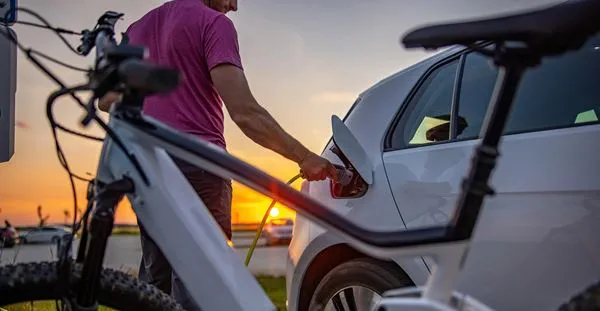Getting in our vehicle and driving to our destination is something many of us take for granted. The convenience and routine of car travel often outweigh the environmental implications and concerns about the growing traffic congestion of the world’s cities. However, as a society, we need to embrace a new mindset not just for our health, but the health of the planet.
In the UK alone, where I call home, tens of thousands of people are negatively impacted by transport. Figures reveal that 30,000 people either die or are seriously injured in road collisions every year, thousands of people die from air pollution, and 17 per cent of people don’t have access to a vehicle, with access half as likely for black people.
Public transport also poses risks with many people subject to abuse, physical harm, and harassment. Additionally, people’s transport needs are often not met, particularly in rural areas, preventing ready access to essential services. A large portion of the housing near major roads is populated by disadvantaged communities who are more likely to suffer the ill effects of air pollution or be involved in an accident.
So how can we implement solutions to plan more sustainable and equitable transport options?
Interrupting the norm
Psychologist Dr Ian Walker conducted a famous study where he coined the term “motornormativity” – that is, we allow the risks in our lives from cars that we wouldn't otherwise accept in other parts of our lives. We also fall for this “is-ought” fallacy which is: just because something has always been the way it has been it ought to be that way.
Society tells us that we need to have a big fast car, however, giving people access to bigger and faster cars is not the solution if we want to work towards a planet-positive future.

Every car occupies around 14 square meters of space and sits idle 95 per cent of the time. If New York’s population grew by an extra 500,000 people by 2035, and only half those people owned a car, they would occupy an additional 3.5 million square meters.
Instead of building more roads and parking infrastructure to manage growth, governments and engineers need to consider some sustainable alternatives to resolve these problems. For example, Transport for London has a goal that by 2050, four out of five journeys will be taken using a form of active travel (walking, bike riding, scooters), or by public transport. And over time, there will probably be greater restrictions on cars and car movements in the city.

Healthy integration of technology
When alternative technology is integrated incorrectly, it can also present threats and generate new problems. For example, Paris had serious issues when hired electric scooters were introduced to the city. After three deaths and 459 injuries while using the e-scooters alone in 2022, the hire scheme was banned, resulting in the removal of 15,000 e-scooters from Paris streets.
In my role as Global Solution Director for New Mobility & Airport Hubs at Arcadis I’m seeing a rapid increase in the introduction of new mobility solutions such as drones and in the not-so-distant future electric vertical takeoff and landing (EVToL). While these are exciting developments to how we move people and goods, we need to consider how they can offset something else, such as road congestion.
Well-considered introduction of technology is crucial, so as a society, we can make progress. For example, if EV charging stations don’t work, are poorly designed, or don’t support disabled drivers, it sets us back. Getting the technology bit right is important but so is the behavior change, the attitude that it's okay to drive if it's an EV won’t resolve our car congestion problems.

A revolution in thinking
There is an opportunity to use technology in a right and just way, but we need to adjust the way we think. Transport options need to urgently become fueled with equity. The first step is to consult people about what services they need access to, and what access needs to be improved.
Countries require a national vision to invest in the necessary transport options to give people access to the services they need. To achieve this, we need a four-step plan;
1. a strong vision for what needs improvement, incorporating sustainable and equitable transport options, supported by an accountable government
2. authentic engagement across industry, community consultation and cross-governmental departments, including health, education, employment and housing
3. shared cross-government investment to create new forms of mobility to meet the changing service access needs and incorporate new mobility ideas, technologies and infrastructure such as bike and carshare, community transport and demand-responsive transport (DRT) and event Advanced Air Mobility (AAM)
4. new tools and data capture to measure progress to enable the national level of collection and sharing of data, measuring who is using what transport to help justify investment.
This vision also needs to be implemented from a regional and local perspective to link national policies to local action plans. Regional and local councils need to authentically engage with all relevant government departments, community services and employers to ensure they are responding to the specific needs of the community.

Importantly, the measurement of infrastructure and whether it is meeting the community’s needs is essential for effective, equitable and sustainable transport solutions.
In the case of Transport for London, there are still shortcomings in transport links relative to residential areas which could improve people’s quality of life. The number of road deaths in the most deprived areas is double that of the least deprived areas, 76 per cent of Londoners don't live within 400 meters of the Strategic Cycle Network and 97 per cent of women aged between 18 and 24 have experienced sexual harassment in public.
A sustainable future can only be achieved if we change the way we invest in transportation projects now, to focus on ensuring everyone gets what they need to thrive.
For more information about working with Arcadis on sustainable project solutions, contact Simon Swan, Global Solution Director for New Mobility and Airport hubs.






